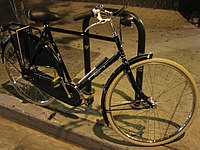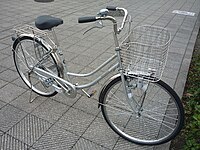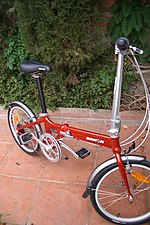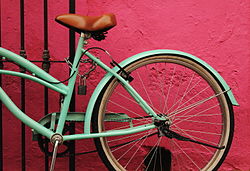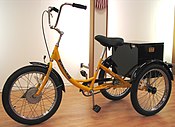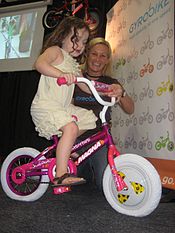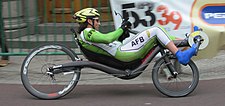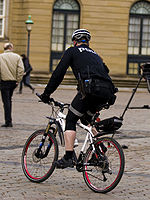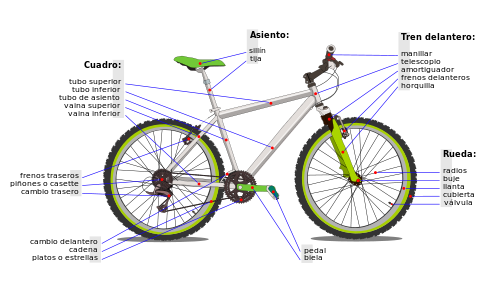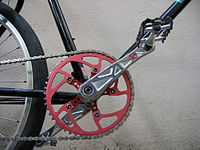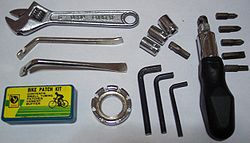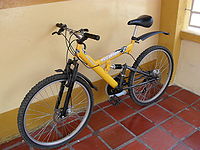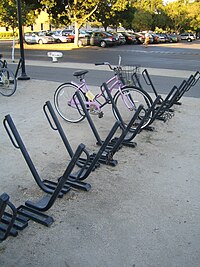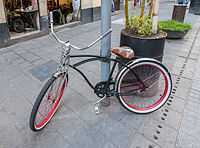Bicycle
The bicycle, colloquially called bici (also known as cicla or ciclo in Colombia, Cuba and Uruguay, chiva or rila, in Mexico and cleta or bici in Chile), is a human-powered personal transport vehicle. It is propelled by the traveler himself, who drives the vehicle with the muscular effort of the legs, particularly by means of pedals or cranks. Its basic components are two wheels, generally of equal diameter and arranged in a line, a pedal transmission system, a frame that gives it the structure and integrates the components, a handlebar to control the direction and a saddle to sit on. The displacement is obtained by turning the pedals arranged symmetrically with the legs, each one with a lever known as a crank, they are assembled in the frame, and in general the right pedal is the one with the largest star or plate where the chain is mounted. which in turn turns the pinion, which finally turns the rear wheel on the ground, thus causing displacement. The basic design and configuration of the bicycle has changed little since the first chain drive developed around 1885.
The father of the bicycle is attributed to Baron Karl Drais, a German inventor born in 1785. His rudimentary device, created around 1817, was propelled by alternately resting his feet on the ground. There are currently more than one billion bicycles in the world, used both as a means of transport and as a leisure vehicle.
It is a healthy, ecological, sustainable and economic means of transport, valid for moving both in the city and in rural areas. Its use is widespread in most of Europe, and it becomes, in countries such as Switzerland, Germany, the Netherlands, Belgium, some areas of Poland and the Scandinavian countries, one of the main means of transport. In Asia, especially in China and India, it is the main means of transportation.
Bicycles were very popular in the 1890s and later in the 1950s and 1970s. They are currently experiencing a new boom and their use is growing considerably around the world due to the high price of fuel, as the bicycle It is very ecological and economical.
History
Alleged background
Until the second half of the XX century, it was accepted that the first antecedent of the bicycle was the celeriferous(célérifère) invented in 1790 by the French count Mede de Sivrac, which consisted of a wooden strip ending in an animal head mounted on two wheels. It had no joints and was propelled by a person sitting astride, propelling himself with his own feet. In the 1950s, however, it was discovered that neither Count Mede Sivrac nor his invention existed; both were created in 1891 by French journalist Louis Baudry de Saunier (1865-1938), copying Karl Drais's design and based on an 1817 patent for a horse-drawn carriage called a celeriferous.
In 1974, a sketch of a bicycle design, propelled by pedals and with chain transmission, found in Leonardo da Vinci's Codex Atlanticus, was disseminated. However, a study of the codex shows that this drawing is not original and was added by a forger during its restoration between 1967 and 1974.
The Draisian
In 1817, the German baron Karl Christian Ludwig Drais von Sauerbronn invented the first two-wheeled vehicle, which he called the walking machine (German: laufmaschine), a forerunner of the bicycle and motorcycle. This "walking machine" consisted of a kind of cart with two wheels, placed one behind the other, and a handlebar. The person was sitting on a small saddle, placed in the center of a small wooden frame. To move, he alternately pushed his left and right feet forward, much like a skater's motion. With this impulse, the vehicle acquired a speed almost identical to that of a carriage. His arms rested on an iron armrest, and in his hands he held a wooden rod, attached to the front wheel, which turned in the direction the driver wanted to go.
This invention was based on the idea that a person, when walking, wastes a lot of strength by having to alternately shift their weight from one foot to the other. Drais managed to create this simple vehicle that allowed man to avoid that job. This machine, initially called draisiana in honor of its inventor and later called more commonly velocipede, the design was quickly improved.
French blacksmith and inventor Pierre Michaux is also considered one of the developers of the modern bicycle.
The pedal bike
Scotsman Kirkpatrick Macmillan is credited with building the first pedal-powered bicycle in 1839. A copy of Macmillan's bicycle is on display at the Science Museum in London, England. Macmillan never patented the invention, which was later copied in 1846 by Gavin Dalzell of Lesmahagow, who spread it so widely that he was for fifty years considered the inventor of the bicycle.
Around 1890, Scotsman John Boyd Dunlop (a cycling enthusiast and creator of the company of the same name) invented a tube made of cloth and rubber, which was inflated with air and placed in the rim. To avoid punctures, Dunlop also invented a rubber tire. These Dunlop inventions have undergone almost no significant changes since their invention.
DHISTRIC SARROLE OF THE BICICLETAEvery time I see an adult on a bicycle, I do not lose hope for the future of humanity.H. G. Wells.
General classification of bicycles
There are various sports modalities, encompassed within cycling, that are practiced with this vehicle. The main classification of bicycles takes into account the function for which they are designed, thus the main types of bicycles are:
The domestic bicycle
The bicycle is the preferred means of personal transportation for many people. 800,000,000 bicycles are used daily in the world, most of them are domestic and commuter bicycles, generically called "urban bicycle" or City-bike (see: hybrid bicycle). They are dedicated to all kinds of daily uses, especially when it comes to traveling numerous short journeys, since they can be traveled four times faster than on foot. Its emphasis on comfort at the expense of weight stands out, with a comfortable seat and handlebars, transmission systems integrated into the hub itself, or with a single gear, mudguards, in addition to generally having one or more baskets for transporting objects. It is also common for them to have urban accessories such as a bell, padlock, lights and retroreflectors.
Traditional bicycles are also on the rise in Europe, following the archetype of classic design but with modern and lightweight components. These include models by Batavus, Gazelle, Kronan and Pashley among many others, which abound in cities such as Amsterdam and Copenhagen (see also: English Bicycle).
Another model that can be found in big cities are the folding ones like the also classic Brompton, whose nice and compact designs optimize its use by combining it with public transport.
The mountain bike
The mountain bike or all-terrain bicycle (MTB) is a bicycle intended for sports in rough terrain, so the resistance of its parts is a main point, as is the protection of its parts against mud and dirt, it also has several gear ratios to adapt the pedaling to the terrain conditions. Sports practiced are Cross country, Freeride, Four cross, Dirt jump and Downhill.
- Bike 29: Bicycle 29 or 29erTwenty-niner, in English) are mountain bikes that use 29-inch wheels.
The racing bike
The racing bike, commonly known as a "road bike," is designed and built for speed, typically featuring a short wheelbase, very vertical front and seat angles, a tall bottom bracket, and very little camber of the fork, this design allows the rider to adopt an aerodynamic position and a more efficient way of transmitting power to the pedals. Likewise, the handlebars vary in design depending on the type of competition so that the cyclist adopts aerodynamic positions.
The typical racing bicycle is built in aluminum alloy and carbon fiber rear triangle and fork, to lighten the frame structure. It has narrow high performance tires (from 18 to 23 mm) and handlebars for a low position, which improves the resistance of the assembly.
Types of racing bikes:
- Bikes for cycling on route
- Cycle bikes
- Bicycles for gravel
- Bikes for races on track
- Bikes for triathlon
- Bikes for races counterreloj
- Bikes for criterium racing
- Bikes for the Tour de France
The touring bike
Long-distance, heavy-duty touring bikes are built for comfort. Stability is increased by its long wheelbase, which keeps the weight balanced, as well as room for front and rear panniers and touring, though some prefer to keep it light and carry only a small toolkit and credit card. Just a few short years ago, the touring bike would have been considered a racing bike all along.
The folding bike
The folding bicycle is a bicycle that can be made smaller by folding it into two or more parts. This type of bicycle is designed so that when not in use, it can be shaped to take up less space, either for storage or transport purposes.
The fact that it can be folded makes it easier to transport and store. Thanks to this, it can be stored at home or at work, its use can be combined with public transport or it can be taken in a motorhome, boat or plane more easily than a traditional bicycle.
The idea of a folding or detachable bicycle is almost as old as the bicycle itself. It is said that every technological novelty in the world of bicycles has already been proven at least a hundred years ago, and as proof, we have the velocipede, which existed in such a form during the 1880s - you could remove the big wheel and fold the frame to house the bike in a specific bag.
Recently, the popularity of this type of bicycle has been growing. During the 1960s, there was an increase in demand for folding bicycles with small wheels. The leaders were Moulton (although despite having small wheels only some models were detachable), and Brompton whose styling in both captured the mood of London at the time. These days, most folding or detachable bikes have smaller wheels than a conventional bike, but for almost every type of bike, from the home commuter bike, to mountain bikes, racing bikes, or even recumbents, a design can be found. folding.
In order to advance the same distance per pedal stroke on a bicycle with smaller wheels such as those of many folding bicycles compared to more conventional wheeled bicycles (26 inches), it is necessary to increase the development in the chainring system. sprocket, i.e. a proportionally larger chainring or a smaller sprocket must be fitted. Contrary to what one might think, this does not mean an increase in the effort that the cyclist has to make to advance, since in reality the development of the bicycle is given by the rear wheel assembly with the plate-pinion transmission and finally the cranks and pedals, that is, the relationship between the movement of the bottom bracket and rear axles, and their respective ends (pedals and rear wheel).
In the 70s, folding bicycles for children or strollers were common, they were simple bicycles, generally without gears. In more recent times, an industry of high-performance folding bicycles has developed, with all kinds of comforts: gears, suspension, etc.
In 2006 sir Clive Sinclair invented a folding bicycle, the A-bike, with minuscule dimensions once folded.
Other types of bicycles
- See also: Amphibious bike.
- Hybrid bike: the hybrid bicycle appeared, with that denomination, a little after all-terrain bikes. Its structure or frame combines characteristics of the road bike and the mountain. Hybrids usually come with 622 mm (700C) wheels such as road/tourism bikes, but with wider tyres of 35-40 mm, narrower than in the mountains but wider than in the road ones. The suspension fork, in case of carrying it, is not as reinforced as in the BTTs. They generally weigh less than these latter and their components are not so resistant. They are designed for use in quiet roads or the city, so they often also equip lights and other safety and utility elements as carriers.
- The beach bike: the beach descends from the bikes introduced in 1933 by Ignaz Schwinn in Chicago, one-way models with wide tires, similar to motorcycles, heavy and uncompromising unless they are driven in plain areas like along the coasts and beaches. Curious also that of these, combined with the BMX, in the mid- and late 1970s, in Marin County, California, the mountain bike was born.
- Tandem: Tandems bring to cycling a new dimension of enjoyment and mechanical performance as with the double of human power but the same front area exalts power/weight, two well-coordinated cyclists in a tandem can advance faster and further than one. The front cyclist decides the direction and controls the marches. The rest of the cyclists are limited to pedaling in a coordinated manner. The most common tandem design is that of two squares, although there are also some with three squares or more.
- BMX: is a small-diameter bicycle and wheels. The size of its most common wheels is 20" and is mainly intended for acrobatics and speed competitions with jumps, usually does not have speed change, but with a fixed relationship.
- Chopper bike or for horseback riding. Bike with seat on the rear axle so that the front wheel can be easily lifted, for example the Vagabundo bike.
- Distribution bike: particularly used in the Netherlands. They are characterized by having the reinforced frame with a second top bar to provide more rigidity to the structure of the bicycle. In addition to the rear transport they have a front grill where to load the goods. Some have a front drawer, so they have greater load capacity, but they are heavier.
- Bicycles of sustainable technologies: Bicis models made in non-conventional materials such as bamboo, plastic and cardboard, among others, are multiplied. They are kind, sustainable and socially conscious. More and more people are looking for an environment-friendly mobility alternative. They have the characteristics of being silent, strong, safe, elegant, light and visible. See also: Sustainable design
- Tricycle: three-wheel bikes. They are very stable and are used to bring young children or go shopping and for the disabled with coordination and balance problems.
- Cuatrical: four-wheel bikes and double pedal for mentally disabled people who usually go with a monitor or companion.
- Children's Bike: Bicycle and Girabicycle help the child develop physical coordination while experiencing freedom and movement.
An innovative trend is the bamboo bicycle, presented at the world forum in Medellín, Colombia, in 2015.
Recumbent bike and hand bike
- The reclining or recumbent bike (recumbent In English), it is a very low type of bicycle in which the cyclist adopts a more comfortable position (especially) but also more aerodynamic, so in plain or favorable terrain it is faster than the classic bicycle, pedaling with the body almost horizontally regarding the ground. The front wheel is usually smaller than the back. Its cost is very high because they are usually custom-made by the cyclist. In some cases it is covered by a braid that is usually made of fiberglass. There are similar tricycles.
- The hand bike is a type of three-wheel bike that is propelled, directed and brakes with the arms. There are models that have double traction (to choose or use simultaneously by the user): by hand or with the legs. There are many models: mountain, walk, and competition. Just as with the petal bike (or driven by leg pedals), these bikes are used for transport, leisure, or competition. See also: Human traction vehicles
Bikes for disabled people
- The hand bike can also be used for all those who have some type of disability in the lower extremities or in the trunk: injured medullars (paraplegics and some tetrapléjicos), amputated, polio etc. That is, for those who, due to some type of disability on the legs or on the trunk, cannot carry a bike driven by the legs.
- Tandem for people with visual disabilities: Tandem is indicated for people who need a companion to guide them.
- Tricycle (or quadruple): The tricycle is a three-wheel bike especially suitable for those who have coordination or balance problems. Just like the generic bike is propelled with the feet and headed with the arms. According to the models, many accessories can be adapted to the specific needs of the user: trunk control systems, special handlebars, supplementary handlebars so that, if necessary, the companion can help direct the tricycle, etc.
Bike trailer and bike trailer
The trailer bike or child carrier bike is an ideal tool for leaving the car parked, taking the children to school every day and exercising. Very comfortable and practical, ideal for children from six to ten years old, too big for the back seat, the trailer bike is attached to a special frame that can be attached to the back of any normal bicycle.
Chacarera bike
The chacarera bicycle, very similar to the English bicycle, is a type of utility bicycle that is used as a heavy load and transport vehicle, its structure is very similar to that of the mountain bike and due to that some people use it they confuse, the difference that this one has no gears, it has a single sprocket (unlike the mountain bike that has a multiple sprocket), it has mud flaps to cover the tires and the chain from the mud, its tires are bigger, thicker and more resistant than the of the mountaineer, its brakes have more force when braking, it has a higher speed than the mountaineer, it is heavier than the mountaineer, it is much more resistant to falls than the mountaineer and can travel in places where the mountaineer cannot can (as cobbled paths); it also has a rack in the back to carry more things (unlike other bikes that can only carry one person, this one can carry two). These bicycles are usually used by peasants on agricultural land, they are used especially to carry large sacks. It is very common to see these bicycles in the mountains of Arequipa, Peru.
Kinds of the bicycle
Other means of transport similar to the bicycle, but that differ by their number of wheels:
- Monocycle, with a wheel: it has neither rudder (wheel) nor brakes, but it does have pedals.
- Tricycle, with three wheels: for very young children; it allows them to learn to move with a safe means of transport.
- Cuatriciclo: It is bicycles with four wheels, double seat, double handlebar and double pedal. The companion can help or simply direct the quadruple (by canceling one of the two directions).
High-end bike
Recently, brands such as Ferrari, Mercedes-Benz, Porsche, BMW and independent brands such as Aurumania have launched models of sports and luxury bicycles on the market. Each one designed their versions of touring bikes, mountain bikes, track and fixed gear or cross country. McLaren and Maserati have shown their prototypes at European auto shows.
Bike-Inspired Gadgets
- Static bike or for exercises: It is an exercise machine with a disc that is powered through pedals and with a friction system whose strength can be regulated to simulate earrings. It usually has a speed meter and a mileage meter. The most sophisticated have pulse counters and make estimative calculations of calories spent in exercise as well as recording data in a memory.
- Electrogenic bike or electricity generator: it can be a static or dynamic bike that allows to get electric power from the pedal, mainly using a dynamo. Electrogenic dynamic bicycles carry a battery, to store the electricity generated and, if necessary, to use it in an electric motor (see electric bike).
Safety on the bike
The inherent risk of riding a bicycle is very low. Of the 3,500,000 regular cyclists in the UK, approximately 10 are killed in accidents that do not involve other vehicles. In terms of road traffic, according to the UK Department for Transport, British cyclists have a death and serious injury rate per million kilometers cycled that is half that of motorcyclists and 8 times that of motorists..
Bicycle safety involves many aspects. The type of bicycle that we have largely determines the specific use that we are going to give it and, therefore, safety may vary. Another determining factor is the terrain where we drive: safety regulations in a city will be different from those that exist in a descent through a mountain.
The following safety aspects must be distinguished and separated: mechanics, protective equipment and driving.
Mechanical safety
For safe use of a bicycle, it must be in good repair. The most important point to consider is the braking system, since without it an accident can easily occur. Other important mechanical aspects include components in poor condition or poorly placed that can easily fracture, bend or detach, causing an accident. Among the most dangerous accidents due to mechanical failures are those that imply that a derailleur or other element gets stuck between the spokes of a tire, that a wheel is suddenly braked by a slack cable or that a wheel is removed in the middle of a jump. Therefore, the mechanics of the bicycle and its maintenance are important for the safety of the cyclist (see the mechanics section).
Protective equipment
Bicycle protection can be grouped into two: personal protection and bicycle safety accessories.
The cycling helmet is a passive safety element that supposedly contributes to reducing the incidence and intensity of head injuries. While some case-control studies have shown a reduction in injuries between 39 and 85%, numerous other statistical studies have exposed a lack of relationship between helmet use and the incidence of injuries, and some even suggest that helmet use of the helmet makes it more likely that other vehicles will hit cyclists. According to a study carried out by the University of Bath in 2006, of 2,500 drivers, when drivers pass cyclists, they leave less space—an average of 8.5 cm least—between your vehicle and a bicyclist wearing a helmet. That is to say, that the space is affected by the appearance of the cyclist, since one comes to think that a cyclist who wears a helmet is more experienced, with which his behavior on the road is more predictable.
There is disagreement about whether helmet use should be mandatory. The main opposition to making the use of a helmet mandatory is based on the idea that such a measure could discourage the use of the bicycle or that a false sense of security encourages cyclists to drive with less caution. of protection for cyclists varies from one country to another. The first law that required the use of a helmet when riding a bicycle was passed in 1990, after 10 years of promoting the use of helmets, in the state of Victoria (Australia). Some countries where helmet use is required in various circumstances are Australia, Canada, Chile, Colombia, the United States, New Zealand, Spain, Finland, Iceland and the Czech Republic. In some cases these obligations are directed exclusively to minors of a certain age or to circulation on roads outside the urban area. In the case of Spain, the legislation requires the use of an approved or certified helmet when riding a bicycle on interurban roads, either as a driver or as a passenger, except for said obligation in prolonged ascending ramps, or for certain creditable medical reasons or in extreme heat conditions.
Other personal protective equipment depends on the particular activity, the most common being knee and elbow pads for the MTB, BMX or Biketrial cyclist. The use of gloves is also recommended to improve driving comfort and to avoid abrasions on the hands in case of falls.
As for the safety accessories for the bicycle, they depend on the type of cycling that is done. So a road bike can make use of a "nail puller", a city bike with headlights, bell or bell and mirror. For city use, the mudguard is very useful to keep the cyclist clean when taking the route after the rain.
Driving
The common element to all cyclists in terms of riding safety is having learned to ride correctly and not get distracted. Let's divide driving safety according to the type of cycling involved. Although driving a bicycle is common to all types, there are particular technical aspects in each type of bicycle as well as in each environment where it is rolled.
Highlights are driving on highways, in fields and roads, as well as in urban areas. Each of the above aspects implies different care. It is usual that on interurban roads you have to drive along the shoulder (or shoulder) of the same, in the event that it exists. On highways there is also usually the same rule, in addition to the fact that in Spain only drivers over 14 years of age can drive on it.
Regarding the urban environment, it is increasingly common for bike lanes to be set up to increase the safety of cyclists. These lanes are usually for the exclusive use of cyclists, disabled vehicles and skaters. In some places, such as Spain and Colombia, on interurban roads, it is mandatory to wear a helmet. Other forms of protection are leather gloves, knee and elbow pads; These last supplements are used especially in high-risk cycling modalities. In addition, in Switzerland, it is mandatory that the bike is covered by a very low-cost policy to be able to circulate.
Safety tips for cyclists
- Drive occupies your lane in town, if you circulate glued to the right you can crash with cars and pedestrians that asoman, car doors that open or be advanced without maintaining a security distance. Make you respect the road.
- Drive in a predictable way — Follow the same tracks as motor vehicles without zigzaguear.
- Notify before moving or stopping — Signs with hands allow others to know what you're going to do.
- Look back – Learn to see on your shoulder without moving the handlebar or losing balance. The use of mirrors is an option.
- It obeys the signs of transit (seeds, signs and lanes) — Cyclists must follow the rules of transit as any other vehicle.
- Follow the marked lanes — Do not turn left from the right lane. Do not go ahead in an exclusive lane to turn right. Take your lane in time.
- Circulate on your right — Always on the right in the sense of road flow. Going against road flow, in addition to a serious breach, is very dangerous.
- Take the streets and intersections with caution, looking well before the situation of pedestrians or other vehicles.
- In town he tries to circulate through quiet streets, avoiding going through the sidewalk.
- It is very important to inform you of the rules of the place where you are driving, as there is no common norm as with other vehicles.
Bicycle Anatomy
There are different types of bicycles, but basically they are all similar, although the components differ in quality, design and weight, as well as in agility and mode of use. In order of importance, a bicycle is made up of the following components:
- Table: The most common, is in the form of rombo, also called diamond or double triangle. The classics were iron or steel; today, when steel is chromium-molybdenum is called "Cro-Moly" or "Cromoly". They can also be aluminum or titanium, or even carbon fiber among other materials.
- Forks: Piece formed by the steering tube holding the front wheel bearing; can be fixed or with suspension.
- Wheels: After the painting, the wheels are the most important element for the performance of the bike. They are the only elements that are in contact with the soil and those that provide the necessary traction for the movement. When the wheels spin, each of them acts as a gyroscope, which helps to balance and stability the whole set.
- Tyre: The tire is part of the wheel and is the combination of a protective cover and an inflatable camera installed around the tire that gives it stiffness and serves as a structure to the shaft of the bike.
- Transmission: Includes external deviant gear changes (dérailleur) fronts and rears and internal changes in the rear wheel hub, both driven by change levers.
- Change lever: Gear changers include fist changers and thumb changers among others.
- Brakes: Includes brake levers and brake systems (brake slippers)
- Power: The power (or handlebar tile), in conjunction with the front fork, are the components of a bicycle that provide an interface with each other with the front tube of the frame.
- Handle: The handlebars vary between a width of 52.5 to 60 cm (21 to 24 inches), the widths allow a control at low speeds while the straits are better for high speeds, the straits are also convenient in the city to run between cars. A type of handlebar is called "Whaltail". It is distinguished from the others in which it lacks the free ends that characterize the traditional handlebar.
- Sillín: Of the existing sillines on the market, some are thin and light to reduce the weight while other anatomical models are designed for comfort.
- Tie of sillin: It is called a seat support tube.
Repair
In many cases, the well-being of the cyclist will depend on knowledge about the repair of a bicycle and its adjustment. It is necessary to know the mechanical elements that make up a bicycle in order to repair and adjust it.
Specifically, it is essential to be able to repair a puncture in the tube (or at least change it), adjust the height of the seat and handlebars, straighten the steering, tighten the brakes and hook the chain. All these operations can be performed with simple and common tools.
Other operations require specialized tools. To assemble and disassemble the links of a chain, the chain truncheon or chain cutter is used.
The pedals are disassembled with a special key that is a flat key, but thinner and with a long arm, and the left pedal has a left-hand thread.
There are wrenches similar to those used for pedals to adjust the hub, since bicycle wheels instead of having deep groove ball bearings usually have angular contact ball bearings. It is necessary to adjust the pressure of the cone, so that it is not loose or braked.
On external gear bikes, a special wrench is required to remove the cassette of sprockets from the rear wheel. In addition, there are several different types, depending on the hub manufacturer.
To change or adjust a spoke (ray in Latin America) of a wheel, a special key is used. To adjust a wheel to prevent it from being warped, out of round, or out of center; and also to assemble it from scratch, a wheel bench is also used, although rough adjustments can be made using the fork of a wheel.
The most common way to adapt a bicycle to a person is through the height of the seat or saddle. This is attached to the post, a tube that is tight on the frame of the bicycle. The taller the person, the higher the seat should be. However, frame dimensions are also important for a proper riding position.
Plugins
- Air pump, also known as inflator, swollen or pump.
- Pads, baskets and other containers to load small goods.
- Children's rear/floor seat.
- Calapiés or scratches, pedal-assed straps for greater grip of the feet.
- Cuernos de goat or Bull.supplements on the handlebars for climbing or clock competition.
- Portabotellines, portabidones or portabotellas in the triangle to carry the drink, usually in a plastic bottle.
- Reflectors, in the edges of the pedals or under the back of the seat, on the wheels, on the conveyor; the fronts are white and the red butts.
- White front and red rear electric lighting; dynamo variant.
- Help wheels, wheels, stabs, stabilizing wheels, coach wheels, training wheels, or auxiliary wheels; to learn how to ride a bike — are two small wheels that place one on each side of the rear wheel. Wheels with gyroscopes can also be used.
- Tool bag under the seat or triangular in the box for basic repairs, with Allen keys, etc.
- The luggage racks allow to hang the racks.
- Horseback or goat leg.
- Knock or horn.
- Trailer to load goods.
- Trailer to take the children.
- In some countries and for children's bicycles, it is mandatory to install a high banderin that makes the bike more visible.
- Helmet, for the protection of the cyclist's head.
- Computer, to monitor various march parameters such as speeds, times, heart rate, etc.
- Toldo, to protect from the sun and the rain.
- Rangers, covered at the height of the wheel to prevent the sludge from the cyclist.
- Cover chains, to protect the chain, the cataline and the pineapple from mud and dirt.
- Rear mirror mirror mirrors on each side of the helm to see what happens behind without having to turn your head around every time.
- Lights, to warn the presence of a moving bicycle in the dark, to avoid shocks and accidents.
- Canasta, which is placed on the rudder in the center of it, which is used to carry small objects.
- Grill, which is placed behind the seat or seat to take a more
- Case or cartridge, to store small things, which is placed under the upper tube that serves to carry a person.
- Covers or covers, which is placed on the rays or rays to protect them from dust and mud.
- Locked chain, to park the bike in a place and prevent it from being stolen.
- Portacelulares, to place the cell phone and so pdoer use it while handling it; there are also waterproofs to prevent the cell phone from getting wet in case it rains.
- Sponge, placed in the handlebars to have a better grip and prevent blisters from coming out in the palms of the hands, is also placed in the upper tube to more comfortably take a person.
Bicycle health
Frequent use of a bicycle has direct health benefits, some of which are listed below:
- muscles: During the pedaling the muscles of the legs are involved; in the abdominal balance, lumbar and back; and when holding the handlebar, shoulders and arms. These muscle trains are exercised with cyclist activity.
- Skeletal system: The use of the bicycle has a positive effect on bone density and strength due to the tension that the body applies on the pedaling and driving of the velocipe. The cyclic movement of the legs stimulates the lower back muscles, where discal hernias are more likely to occur. This way the spine is reinforced and ensured against external tensions. In particular, cycling can stimulate the small muscles of vertebrae that are difficult to affect through another exercise. This can help reduce the likelihood of back pains and other problems.
- Protection of joints: Cycling is especially good in cartilage protection and feeding as the support of the bike is that the forces acting as a result of body weight are drastically reduced. The circular movement of the bicycle helps transport the metabolic energy to cartilage, reducing the likelihood of osteoarthritis.
- Stress: Cycling has a considerable relaxing effect due to its uniform, cyclic movement that stabilizes the physical and emotional functions of the body. This counters anxiety, depression and other psychological problems. Exercise also controls hormonal balance.
- Oxygenation: Breathing is often affected by adiposity and lack of exercise. Among other things, regular and moderate physical activity strengthens breathing muscles, leading to better ventilation of the lungs and therefore has a positive effect on the exchange of oxygen.
- Heart: Cycling is ideal for heart training and making it stronger and less prone to heart disease. By using a bicycle all risk factors leading to a heart attack are reduced and by doing so regularly the risk of heart attack is minimized by more than 50%.
- Obesity: Cycling is ideal for facing obesity problems because 70% of the body's weight falls on the seat, thus allowing people who otherwise could not easily move to exercise to improve their physical form and stimulate fat metabolism. In turn, the use of the bicycle contributes to weight reduction by burning energy.
- Colesterol: Cycling can train the body to use fat reserves favoring the balance in cholesterol level. Regular exercise during youth is a prevention factor against excess weight in adults.
- Blood pressure: Moderate cycling can prevent, or at least reduce, high blood pressure and thus help prevent stroke or damage to organs. Blood pressure is reduced to lower heart rate, which is the result of regular aerobic exercise.
- Cancer: Regular physical activity has been shown to reduce the risk of colon, breast, prostate, and pancreas cancers, and possibly of lung and endometrial cancer.
- Resistance: Cycling is especially good for aerobic exercises as tension in the body is lower than in other resistance sports. Increase resistance capacity reduces fatigue and fatigue, this promotes a sense of well-being.
- Beauty: Beauty and attractiveness are very linked to the shape of the body and condition. Cycling can positively influence them by controlling body weight and muscle form. The skin also benefits from metabolic processes that are stimulated. In addition, cycling affects physical sensation that influences the perception of others.
- Physical training: In addition to regular moderate exercise, the body benefits from increased demanding activity from time to time, which improves the physical state and provides greater distraction of everyday problems. Cycling can provide a more intense activity simply by pedaling faster or stronger.
- Quality of life: Physical activity has a direct effect on well-being and health. Cycling has many advantages that can directly influence the quality of life, as it brings benefits both physically and emotionally. Regular exercise, taken as an integral part of daily life, is necessary to permanently improve the quality of life.
- Side benefits: More cycling, especially as an alternative to car trips, would bring substantial benefits to the health of society as a whole, due to the best air quality, noise reduction and danger, and greater independence for children.
In addition to the health benefits mentioned above, it is necessary to point out that any physical activity must be carried out under medical supervision and, in the case of cycling, go to an expert to choose the correct size of your bicycle and adjust it to your anthropometry to avoid possible injuries or accidents.
Standardization
Within ISO, the Technical Committee "ISO/TC 149 Cycles" is in charge.
Cycling competitions
Competitive cycling is one of the toughest sports in the world[citation needed].
Non-exhaustive list of some of the main professional cycling competitions:
Culture
The bicycle has been the protagonist in films such as Bicycle Thief (1948), Death of a Cyclist (1955), E.T., the Extra-Terrestrial (1982), Los bicivoladores (1983), Bicycles are for the summer (1984), Cinema paradiso (1988), The Postman (and Pablo Neruda) (1994), Ghislain Lambert's Bike (2001), The Bike (2006) and The Bike verde (2012) and in books such as Forced by the Road: Tour de France 1924 (2009), Sky's The Limit (2013), Ladies on a bicycle (2014), My dear bicycle (2014) and Cyclists and runners from Madrid (2015).
Contenido relacionado
Advanced Encryption Standard
Hafnium
Edgar Frank Codd







